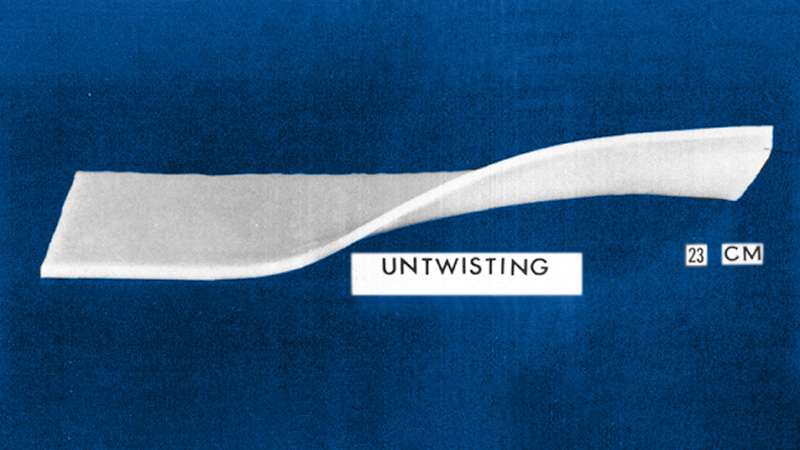
Practice Perfect 876
The Twisted Plate: A Simple but Useful Biomechanical Model
The Twisted Plate: A Simple but Useful Biomechanical Model

In the world of lower extremity biomechanics, with all its new research, technology, jargon, and challenges, it can be hard for practicing podiatrists and training students and residents to have simple, clear, useful strategies for directing treatment. In the past, I’ve spent a large number of Practice Perfect editorials discussing decision-making in the attempt to make this challenging process a little more manageable. To that further end, let’s do a quick review about an important concept that is much older than most of us realize: the foot as a twisted plate.
Way back in 1944, MacConaill wrote his paper about this concept1 which he termed the “lamina pedis.” Now, on the surface this concept of the foot as a flat plate that is twisted appears very simple and maybe even obvious. Yet, despite how obvious this may be, I was never taught this concept in school. It actually wasn’t until later that I was introduced to the concept and somewhat later that I read MacConaill’s paper. Sarrafian also discussed this in his excellent anatomy textbook2.
As a quick summary, MacConaill described the following:
- The human foot is a type of twisted osteofibrous plate of irregular thickness (a curved plate rather than a flat one).
- The anterior aspect of the plate is everted while the posterior aspect of the plate is inverted.
- In the planus foot, the plate is “untwisted”, while in the cavus foot the plate is “twisted” more tightly.
- Joints can attain a synarthrodial position in which the joint surfaces are congruent, creating a close-packed position. In this position, ligaments are tight, and the joint is “screwed home.”
- The synarthrodial joint position is attained when the forefoot (anterior aspect of the plate) is everted and the hindfoot (posterior aspect of the plate) is inverted.
- Movement back and forth between the close-packed and open-packed positions allows for decreased and increased flexibility of the foot, respectively.

So, what’s the big deal? It’s obvious, right? We’ve been talking about this idea for years, and it’s literally old news, right? It is old, but I don’t think it has been well appreciated except by a few people such as Doug Richie, Jr, DPM in his excellent textbook, Pathomechanics of Common Foot Disorders (another important book to read).
First, without getting into the details, the concept of the close-packed joint position has been validated by several researchers, including for the calcaneocuboid and 1st tarsometatarsal joints, and significant research has arisen from this. This is the very reason the bony structure of the foot is able to provide a sometimes rigid and sometimes flexible arch during gait.
Second, this model provides an excellent set of goals for foot orthotic therapy. Have a patient with a flatfoot problem? Use the foot orthosis to wind up the foot by everting the forefoot and inverting the forefoot. Have a patient with a cavus-related issue? Apply forces using a foot orthosis to unwind the foot. For patients with plantar fasciitis and a supinated forefoot, I utilize forefoot valgus posting to wind the forefoot. This method has been validated by Kogler, who found only forefoot valgus posting decreased plantar fascial strain3. Consider for a moment that this orthotic prescription component opposes what many of us are taught in school. Rather than accommodate a supinated forefoot – as many of us are taught – this model suggests we should evert the forefoot to reduce strain.
Similarly, the choice of surgical procedures for these conditions can be made easier by considering the lamina pedis concept. Procedures such as the Cotton midfoot osteotomy create a relative forefoot valgus, which has a “winding up” effect on the forefoot, consistent with MacConaill’s concept.
The foot as a twisted plate, the lamina pedis, though 79 years-old, is even more important today than it was when first published.
Best wishes.

Jarrod Shapiro, DPM
PRESENT Practice Perfect Editor
[email protected]

-
MacConaill MA. The Postural Mechanism of the Human Foot. Proceedings of the Royal Irish Academy. Section B: Biological, Geological, and Chemical Science 1944 Jan 1 (Vol 50, pp 265-278). Royal Irish Academy.
Follow this link -
Sarrafian S. Functional characteristics of the foot and plantar aponeurosis under tibiotalar loading. Foot Ankle. 1987 Aug;8(1):4-18.
Follow this link -
Kogler GF, Veer FB, Solomonidis, Paul JP. The influence of medial and lateral placement of orthotic wedges on loading of the plantar aponeurosis. An in vitro study. J Bone Joint Surg. 1999 Oct;81(10):1403-13.
Follow this link
































Comments
There are 0 comments for this article